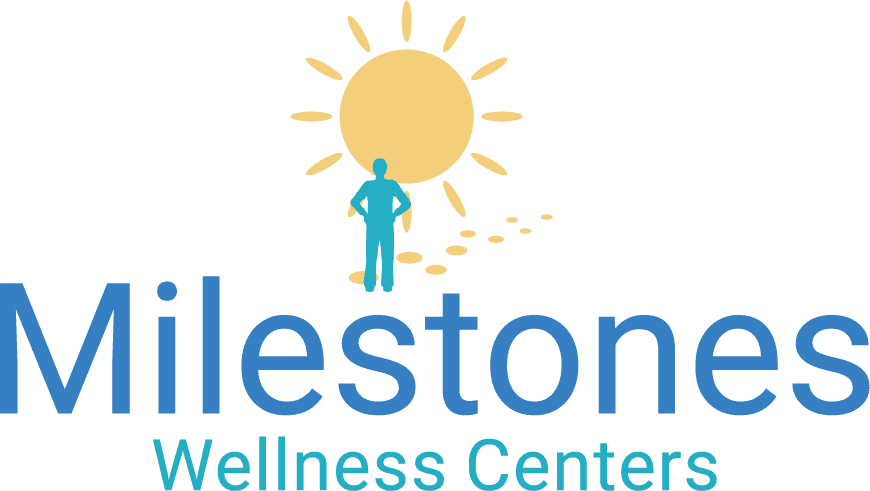As many will look back at COVID-19 as only a horrific pandemic the world went through, which it was, but there was at least one positive that happened. This is bringing the realm of opioid addiction treatment as well as other realms of substance abuse treatment into the world of telehealth or telemedicine. Thanks to what telehealth or telemedicine can offer it greatly can assist with overcoming many previous barriers individuals had when seeking addiction treatment, one being that for Opioid Use Disorder, such as that at Milestones Wellness Centers.
Even though someone may desire to get treatment for their addiction they may face barriers that prevent them from obtaining such treatment. Thanks to these advances in telemedicine clinics such as here at Milestones Wellness Centers, we can overcome some if not many of the barriers to these treatments. And it is the goal at Milestones Wellness Centers to continue to break down barriers and offer treatment to anyone desiring to start their path to recovery. So, what are some of the barriers to addiction treatment? Most commonly they all surround accessibility and affordability, but there can be other barriers such as stigmas associated with such treatment.
Accessibility Barriers
What are the accessibility barriers to addiction treatment and how can we overcome them? Just being able to attend treatment is the most basic accessibility issue. On this one point of accessibility issue there are many contributing factors. First, for some, may be that there is not a treatment facility that is close to your residence. As this has been the case for many that live in more rural areas, the advancement of telehealth has overcome this barrier, bringing treatment options to anyone in the state(s) that facility is licensed to operate. With telehealth as long as the facility and medical providers are allowed to operate in your state, they can assist with anyone in the state regardless of their precise location. This opens treatment to those that live far from a facility’s physical location by allowing for the use of telehealth.
Like the barrier of not having a treatment facility near you, a person may have transportation problems making it even if a facility is in their town. Many areas in the country have a lack of public transportation or at times may not have the finances to utilize other transportation options. And some that have no transportation options in more rural areas also may not own or have access to a vehicle. Even if someone owns a vehicle, they may not have a currently active driver’s license and are allowed to legally drive or have the finances for gasoline or insurance. All these potential barriers to opioid addiction treatment are overcome with the advances of telehealth. Even if someone has no transportation barriers there can always be issues that happen unexpectedly, such as a breakdown, traffic accidents, or other unforeseen problems. Again, with telehealth the person would still be able to make their appointment and stay on track with their recovery.
A second accessibility barrier could be the time in which the treatment facility is open to operate. Looking at a traditional in person facility, it will often be open Monday through Friday during standard business hours of early am hours till around four or five in the afternoon. Also, this is also a common time that people are working. Attending in-person appointments at such a facility would require the person to take time off work if their schedule conflicted. This is not just the time required for the appointment but as well as the time to drive to and from the treatment facility as well as any time waiting for the appointment to start and potential drug screenings. As much as this is an accessibility issue this can also relate to the next barrier, which is affordability. Missing vast amounts of work on a frequent basis can cause someone to make less money which can impact treatment outcomes or with the continuation of treatment.
Affordability Barriers
Affordability is often a barrier to treatment for many. Luckily often telehealth options are more affordable for people who do not have health insurance. The reason for telehealth being cheaper has nothing to do with the quality of care, but all to do with the costs associated with running a business. If completed properly telehealth can run more efficiently than that of typical in-person offices with the use of technology and decreasing the number of missed appointments. In the realm of addiction treatment unfortunately individuals no show their appointments are common. When this happens the staff still need to be compensated for their time even if an appointment is not happening. When this increases, the overall cost associated with all appointments must increase to keep the revenue equal to what must be paid out to operate. This is a huge reason why making your scheduled appointments is important.
With telehealth and how efficient the process is, it causes a great decrease in how many no-show and cancelled appointments there are. Thanks to this efficiency telehealth can decrease the cost associated with the treatment they provide, whether it is for opioid addiction treatment or any type of healthcare as telehealth is now seen in a large portion of healthcare industry. For those with insurance the cost associated is often not a concern, but not everyone is fortunate enough to have health insurance or have a large out-of-pocket deductible to meet. With those deductibles the lower costs do not help the person meet that deductible quicker but does make the financial constraints of such treatment easier for each appointment.
Another way that telehealth helps in the affordability of treatment is with the logistics of how telehealth operates. As telehealth can be done from the convenience of your home, you do not have to travel to an office. That travel costs money and therefore decreases in the overall cost associated with treatment for the patient. And with the how more efficient the timing of telehealth appointments is it saves a person the time of traveling to and from the office as well as not having to sit in a waiting room. This will save a person from having to take any time off work, ultimately allowing the person to be available to make more money. The last cost savings associated with telehealth is for those that would have to pay someone for childcare during the time they would have to be traveling and attending their in-person appointment, again saving the person money.
Stigma Barriers
Another advantage of telehealth is that your treatment can truly be 100 percent confidential. By attending an in-person treatment facility it is completely possible for other people to observe you physically being at the location. Someone may notice you entering the facility by driving past you at the time you are entering it, or you may see someone else while inside the treatment facility. Either way, when using telehealth, you can do this from any location of your choice making it completely unknown to others if you choose. Some people may have decided to not start treatment due to the concerns associated with the stigmas around treatment, which telehealth removes for those individuals.
Additional Treatment Concerns
For some there are other concerns with in-patient treatment which are alleviated with the use of telehealth. Many in addiction treatment have few if not many triggers which can cause severe cravings for substance usage which could lead to a brief lapse or full relapse. Some of the common triggers are people, places, and things. Of these possible triggers, seeing others you know during your active addiction can easily be a major trigger. With in-patient treatment a person may run into these people, causing a trigger, which is eliminated with the use of telehealth. Another trigger is being around anyone that is offering you substances or actively using substances even if there is not a personal connection with that individual. As all clinics strive to make sure nothing of this nature is happening on their premise, at times people in the parking lots of clinics may be offering those going in and out of the facility some substances, which the clinic staff is unaware of. This can easily be a trigger for someone and again is avoided with telehealth.
Efficiency with many medical facilities is a point of frustration for patients. As mentioned previously with telehealth, if ran properly, can be extremely time efficient. This assists in the barriers of affordability and accessibility, it can also remove this frustration to the treatment for patients. At times some people may cease treatment due to frustrations of many areas, therefore removing any frustration will increase the chance of treatment success and recovery.





